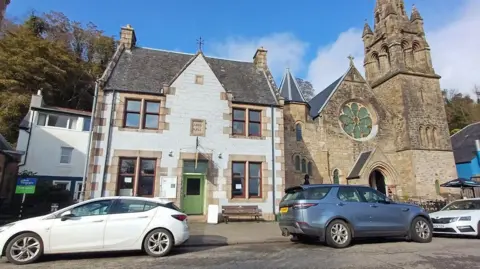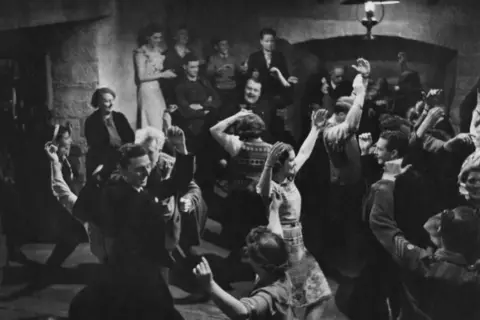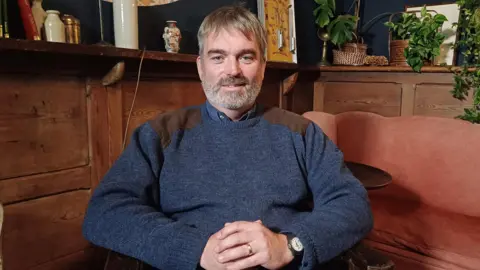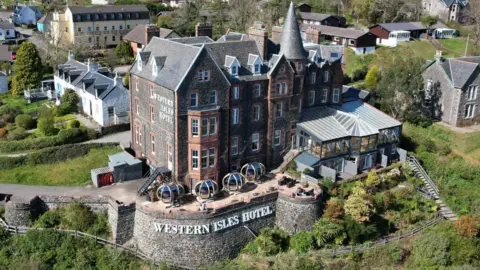How one of Martin Scorsese's favourite films brought Gaelic to the movies
 Getty Images
Getty ImagesEighty years ago a small crowd gathered in a hall in Tobermory on Mull for a preview screening of I Know Where I'm Going.
Produced by two legends of British cinema, the romantic comedy used locations on the Hebridean island and featured residents in the cast.
Hollywood director Martin Scorsese describes it as one of his favourite movies, and credits its makers - Michael Powell and Emeric Pressburger - for influencing his own work.
What is less well known is I Know Where I'm Going brought Gaelic to the big screen for the first time.

Mull was treated to three preview screenings in November 1945 - two days before the film's London premiere.
Takings from the shows were donated to local charities, with the Oban Times reporting at the time that the "generous gesture" was "deeply appreciated".
Englishman Powell and British-Hungarian Pressburger were among the biggest names in cinema at the time, and are known for films including The Life and Death of Colonel Blimp and The Red Shoes.
Powell had a keen interest in Highland history and culture and had previously made The Edge of the World, a film based on the evacuation of the last islanders from the remote archipelago of St Kilda.
 I Know Where I'm Going/The Archers
I Know Where I'm Going/The ArchersI Know Where I'm Going was filmed between Mull and studios in Buckinghamshire in 1944 and 1945, while World War Two was still being fought.
It tells the story of an Englishwoman played by Wendy Hiller who sets out to travel to the fictional Scottish island of Kiloran to marry a wealthy businessman.
She is stranded on Mull though during a storm and falls in love with Roger Livesey's Royal Navy officer who is home on leave.
Livesey was also performing in a play in London's west end at the time and did not travel to Scotland for scenes there.
A double was used and the footage inter-cut with close-up shots recorded in the studio.
Powell later said he believed it was one the cleverest things he had done in cinema.
After its premiere, the film was released to the public in December 1945 and became a hit at the box office and among critics.
Scorsese, whose films include Goodfellas and Killers of the Flower Moon, has described Powell and Pressburger as "kings of British cinema".
He said their films were "dynamic, magic, inventive and endlessly surprising".
Powell, after a period of critical obscurity and financial hardship following a downturn in his career, became friends with Scorsese in the 1970s.
He moved to the US where he met and married Thelma Schoonmaker, who has edited every Scorsese feature film since Raging Bull in 1980.
They were married until his death in 1990 and she and Scorsese keep his legacy alive today. Schoonmaker has taken part remotely in a weekend held in Mull to celebrate the film's legacy.
 Getty Images
Getty Images Getty Images
Getty ImagesAs well as telling the film's story, Powell and Pressburger wanted to give viewers a sense of the island's community and culture.
As part of that, they decided to use Gaelic.
In his autobiography, Powell said they wanted to give as accurate a picture as possible, and they brought in a Gaelic consultant to advise.
The language is heard at various times in the film, between snippets of everyday conversation among islanders and the songs Ho-rò Mo Nighean Bòidheach and 'S Truagh nach robh Mise ann an Eilean Mo Chridhe, which are sung at a ceilidh.

One native Gaelic speaker was among the main cast - Murdo Morrison, from Borve in Lewis, who played a young man paid by Hiller's character to carry her to Kiloran during the storm.
Subtitles were not used, leaving viewers to understand the meaning of the language from the context, a method the directors had used in other films.
Although Gaelic was heard in a short documentary about Eriskay by German filmmaker Werner Kissling in 1935, I Know Where I'm Going was the first time dialogue in the language appeared in a feature film.
Mull-based director and film-maker Alasdair Satchel praised the use of Gaelic.
"They don't look down on the language or the culture, it's elevated in the film," he said.
"They're speaking the language, they're singing it - they're expressing culture, something which is important to this place."

Many locals from Mull also appeared on screen, Gordon Maclean's grandmother, Polly Sharp, among them.
Mrs Sharp had a taxi and drove Hiller to location each day, and that was how the opportunity to appear on screen presented itself.
Her grandson said: "One day they were down there and Wendy Hiller was ill.
"So they decided that since my granny was round about the same size, they could make use of her as a stand in."
She appears in a scene involving the lead characters walking arm in arm down a road.
Mr Maclean said: "I think she loved it, with all these people from the glamour of the film world coming to Mull.
"This was at the tail end of the war as well, a grim time for everybody.
"So it must have been quite a beautiful thing to happen for everybody that was involved in it."
'Expensive hat'
There appears to have been a good relationship between the production team and the locals.
Mr Maclean said: "My granny always called Michael Powell 'Micky Powell'.
"She would definitely not have called him that unless it was at his request. It's obvious they got on well."
He said he had seen a photograph of his grandmother and Powell together.
"My granny is wearing Wendy Hiller's clothes, and a very expensive ocelot hat, which apparently cost £90," he said.
"My granny always related this story that she'd said to Micky Powell: 'I can always say I had £90 on my head even though I've never had it in my hand.'"
 The Western Isles Hotel
The Western Isles HotelThe film continues to have an impact on Mull today.
The Western Isles Hotel, perched above Tobermory, is one of the locations featured.
A group of experts and admirers of I Know Where I'm Going - who call themselves IKWIGers - gathered there for a weekend last month, something they do every five years.

Hotel manager Bryan Botha said: "People come here to experience the film, either if they're a massive fan, or people come because they've seen it or a relative has seen it.
"We've got posters up around the hotel and sometimes we do screenings as well.
"There's still a lot of remembrance and fondness for the movie."
Mull film-maker Alasdair Satchel added: "It's part of our story here.
"People are proud of it - it's our film and adds another dimension to how Mull is seen in our collective narrative."
